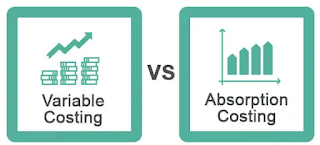Absorption Costing vs. Variable Costing: An Overview
Variable cost is the accounting method in which all the variable production costs are only included in product cost. In contrast, Absorption costing is where all the absorbed costs are taken into account. Under this method, all the fixed and variable production costs are deducted, and then fixed and variable selling expenses are deducted.
Costs
· Variable Costing -- Variable costing consists of simplest variable expenses without delay incurred in manufacturing.
· Absorption Costing -- Absorption costing consists of each variable expenses and glued expenses associated with manufacturing.
Alternative Names
· Variable Costing -- Variable costing is likewise referred to as marginal costing or direct costing.
· Absorption Costing -- Absorption costing is likewise referred to as complete costing.
Internal / External Use
· Variable Costing -- Variable costing is usually used for inner reporting purposes. Managerial choices are taken on the idea of variable costing.
· Absorption Costing -- Absorption costing is used for reporting to the outside stakeholders in addition to for the reason of submitting taxes.
Relevance
· Variable Costing -- Variable costing is used for evaluating the profitability of various product lines. The corporation can perform an evaluation primarily based totally on expenses, volumes, and profits.
· Absorption Costing -- Absorption costing is used for calculating in step with unit value primarily based totally on all expenses which include constant overhead expenses.
Reporting
· Variable Costing -- Variable costing is primarily based totally on inner specs of reporting and presentation.
· Absorption Costing -- Absorption costing is primarily based totally on outside reporting requirements given through outside agencies.
Inventory
· . Variable Costing -- Variable costing includes simplest variable manufacturing expenses to be assigned to stock, work-in-progress, and value of products sold.
· Absorption Costing -- Absorption costing includes thinking about all manufacturing expenses and which include them in stock and work-in-progress.
Contribution
· Variable Costing -- Variable costing calculates contribution that's the distinction among income and variable value of income.
· Absorption Costing -- Absorption costing is used to calculate the internet profit.
Profit
· Variable Costing -- Profit is lots less complicated to are expecting as it's far a characteristic of income.
· Absorption Costing -- It is lots greater tough to are expecting the impact of extrade in income on profit.
How would a knowledge of cost behavior patterns such as those above be of help to a manager in analyzing the cost structure of his or her company?
A knowledge of cost behaviour patterns such as variable cost, fixed cost or semi-variable cost helps in analysing the cost structure of the company. It helps a manager in following ways:
· It helps in forecasting the cost for the future period. Variable costs vary based on activity level. Fixed cost is fixed for a given range of activity and mixed cost is based on activity level
· It helps in various decisions making like Make vs. buy, acceptance of special order, continue or discontinue of products, division, or departments. Variable costs are relevant costs in evaluation and fixed costs are sunk costs and not relevant costs.
· It helps in cost volume profit analysis such as break even analysis and margin of safety analysis. Break even analysis is the analysis at which there is no profit or loss to the firm. Margin of safety analysis is the sales level which gives profit to the firm
· It helps in cost management to control costs and reduce costs.
· It helps in flexible budget preparation for the firm. Flexible budget is a variation of static budget for actual level of activity
· It helps in new product launches, product costing and product pricing
· It helps in determining profitability statement at different levels of activity.
· It helps in forecasting the cost for the future period. Variable costs vary based on activity level. Fixed cost is fixed for a given range of activity and mixed cost is based on activity level
· It helps in various decisions making like Make vs. buy, acceptance of special order, continue or discontinue of products, division, or departments. Variable costs are relevant costs in evaluation and fixed costs are sunk costs and not relevant costs.
· It helps in cost volume profit analysis such as break even analysis and margin of safety analysis. Break even analysis is the analysis at which there is no profit or loss to the firm. Margin of safety analysis is the sales level which gives profit to the firm
· It helps in cost management to control costs and reduce costs.
· It helps in flexible budget preparation for the firm. Flexible budget is a variation of static budget for actual level of activity
· It helps in new product launches, product costing and product pricing
· It helps in determining profitability statement at different levels of activity.
Tags:
Education

